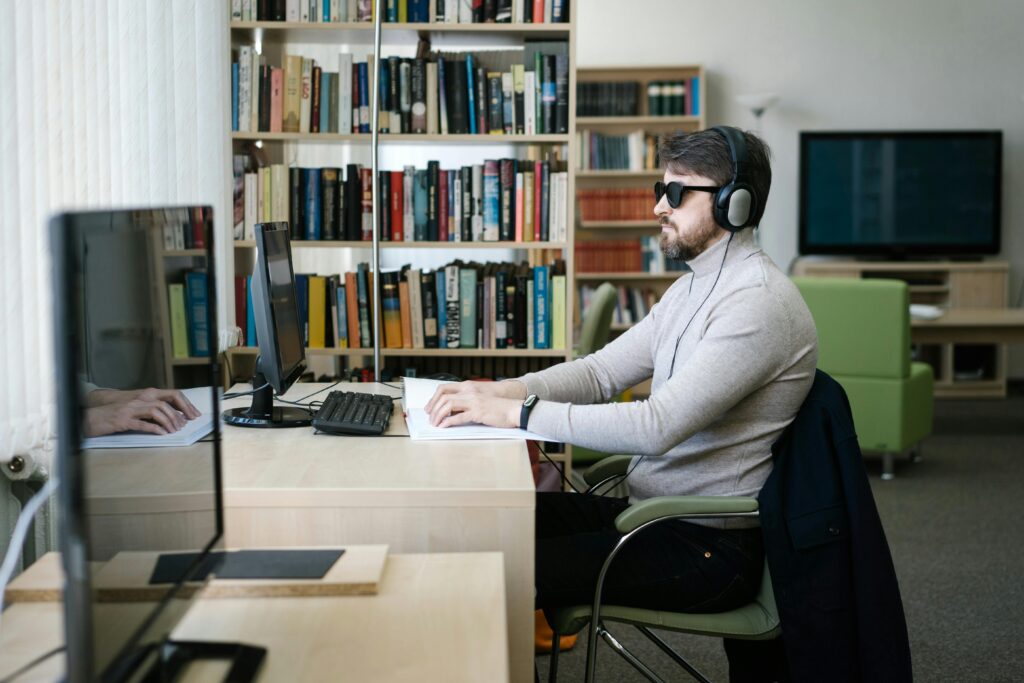
Seeing the world differently doesn’t mean seeing it with limits.
From smart glasses to label-scanning apps, the right tech doesn’t just offer access. It puts us in control.
Tech for low vision users doesn’t ask for pity. It delivers power. These tools go in our hands, on our faces, and into our daily lives to help us live more independently, efficiently, and fabulously.
Tech doesn’t belong to one kind of user. Some of us are blind, some have low vision, and some use multiple kinds of access tools. Whether you use a screen reader every day or just need help in certain settings, this tech isn’t about fitting in. It’s about thriving.
Disability doesn’t limit potential. Bad design does.
That’s not a slogan. That’s the truth.
Be My Eyes: Community-Powered Visual Assistance
Be My Eyes connects blind and low vision users with sighted volunteers who provide real-time visual help over video. You can check expiration dates, identify colors, or locate something you’ve dropped. Just open the app and get matched with someone who’s ready to assist.
Why it works: It’s free, fast, and turns access into connection.
“I started using Be My Eyes because I didn’t want to keep texting my niece every time I needed help reading a label. It’s fast, easy, and makes me feel like I’ve got a team in my pocket.”
— Angela M., legally blind, Virginia AudcityMagazine subscriber
OrCam MyEye: Wearable AI for Reading and Recognition
🔗 https://www.orcam.com/en/myeye
OrCam MyEye is a small, voice-activated device that clips onto glasses and reads printed or digital text out loud. It can also recognize faces and products, delivering spoken feedback instantly.
Why people use it: It’s discreet, accurate, and doesn’t require a phone to work.
Envision Glasses: Smart Glasses That Describe the World
🔗 https://www.letsenvision.com/glasses
Envision Glasses use Google Glass hardware to scan and read text, describe your environment, and provide guided navigation. Paired with the Envision app, they stay updated with features requested by real users.
What sets them apart: They’re lightweight, modern, and focused on everyday use.
WayAround: Label Everything, Live Freely
WayAround combines NFC tags and a mobile app to let you label items throughout your space. Scan a tag with your phone to hear your custom label. It works for everything from spices to laundry instructions.
Everyday win: Label leftovers with reheating steps, organize clothing by color, or add medication reminders.
“I use WayAround to label everything in my kitchen and closet. No more mystery leftovers or mismatched socks. It changed how I live in my own home.”
— Marcus L., totally blind, New York Reddit
Built-In Accessibility Features: Tools Already in Your Pocket
You don’t need expensive gear to get visual support. Your smartphone likely already includes:
- VoiceOver (iOS) or TalkBack (Android) for screen reading
- Magnifier apps with zoom and color contrast
- Dark Mode to reduce glare
- Text-to-Speech and Speech-to-Text for easier reading and writing
Quick tip: Spend ten minutes in your Accessibility settings. You might find something that saves you time and energy every day.
Final Thought: Tech for Low Vision = Tech for Liberation
Have you used any of these tools? Which ones help you most? Which didn’t meet your needs? Drop your thoughts in the comments. This space belongs to all of us.
Every item on this list exists to support independence. These tools aren’t about catching up. They’re about leading in design, innovation, and freedom of choice.
And let’s be honest — many of these features started as disability tools and ended up going mainstream. Dark Mode. Voice control. Text dictation. That’s universal design in action.
If you’re tired of being underestimated, share this article. Add your voice in the comments. Stay connected and stay visible.
Coming Up Next: [Tech That Lets Us Hear]
Next week we’ll cover hearing tools, captioning apps, and the sound-enhancing tech we’re loving right now.
Subscribe to the weekly newsletter. Do it before October. That’s when it will no longer be free. Click here.
Support independent disability media:
☕️💥 BuyMeACoffee.com/AudacityMagazine
Too many people treat disability like a hashtag for clicks. We’re not a trend. We’re a movement.
We’re still here, still building, still audacious.